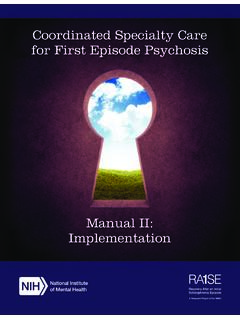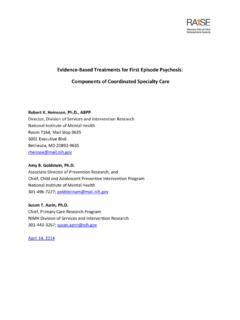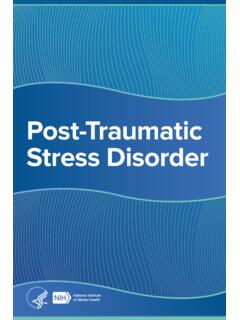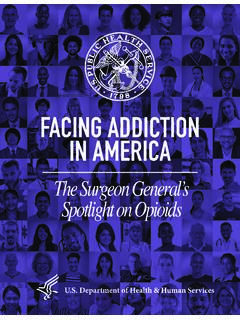Transcription of African American Youth Suicide: Report to Congress
1 African American Youth Suicide: Report to Congress Department of Health & Human Services October 2020. 1. Contents Abbreviations .. 3. Executive 4. Introduction .. 5. Youth Suicide Demographics and Epidemiology .. 5. Risk Factors Associated with Higher Suicide Rates among Black Compared to White Youth .. 7. Evidence-Based Interventions to Prevent Youth Suicide Ideation and Behavior .. 13. HHS Youth Suicide Prevention Initiatives .. 18. References .. 19. APPENDIX A .. 23. APPENDIX B .. 33. APPENDIX C .. 39. 2. Abbreviations ACE Adverse Childhood Experience ACF Administration for Children and Families AHRQ Agency for Healthcare Research and Quality CBC Congressional Black Caucus CDC Centers for Disease Control and Prevention HHS Department of Health & Human Services HRSA Health Resources and Services Administration IHS Indian Health Service IOM Institute of Medicine (now National Academy of Medicine). NIH National Institutes of Health NRC National Research Council NVDRS National Violent Death Reporting System SAMHSA Substance Abuse and Mental Health Services Administration YRBSS Youth Risk Behavior Surveillance System 3.
2 Executive Summary Congress requested the Department of Health and Human Services (HHS) to submit a Report examining reasons for why Black children aged 5 to 12 are dying by suicide at nearly twice the rate of their White counterparts. To supplement the limited research that investigated reasons for higher suicide rates in Black children compared to White children, we analyzed National Violent Death Reporting System (NVDRS) data between 2014 2017, to examine the risk and precipitating factors in 274 non-Hispanic Black children and 1992 non-Hispanic White children aged 10 to 17, who died by suicide. Compared to their White peers, Black Youth had higher rates of experiencing a crisis in the two weeks prior to their death by suicide, had a family relationship problem, argument or conflict and a history of suicide attempts. In contrast, Black Youth had lower rates of a current known mental health problem, current depressed mood, a history of suicidal thoughts or plans, and either a past or current treatment for mental illness compared to White Youth .
3 Lower rates of current or past mental health problems despite higher rates of past suicide attempts suggests that Black Youth have limited access to and/or utilization of mental health services. Early detection and mitigation of modifiable risk factors for suicide, including identification and treatment of mental health issues, interpersonal problem-solving skills training, and family-based interventions that improve interactions are critical components of evidence-based suicide prevention interventions in Black children and Youth . Prevention of the downstream outcome of death by suicide in Black children and Youth cannot be achieved without actively addressing the upstream risk factors such as healthcare disparities, and social determinants of health including racism. 4. Introduction This Report responds to the following language from H. Rept. 116-62, which was incorporated by reference in the explanatory statement accompanying the FY2020 Further Consolidated Appropriations Act ( 116-94): African American Children and Suicide.
4 The Committee is concerned that the suicide rate among children aged 10 to 17 increased by 70 percent between 2006 and 2016. The Committee is also concerned that African American children aged 5 to 12 are dying by suicide at nearly twice the rate of their white counterparts. Accordingly, the Committee directs the Office of the Surgeon General to submit a Report on this pressing public health issue, within 90 days of enactment of this Act, including an examination of factors that may be causing this disparity as well as evidence-based interventions. The Surgeon General should collaborate with the CDC, SAMHSA, ACF, the National Institute of Minority Health and Health Disparities, the National Institutes of Mental Health, and the National Institute of Child Health and Human Development, as appropriate. This Report builds on and augments the excellent, recent publication by the Congressional Black Caucus (CBC) Emergency Taskforce on Black Youth Suicide and Mental Health, Ring the Alarm: The Crisis of Black Suicide in America.
5 Consistent with the CBC Report , the present Report uses the term Black to include not only African Americans but also individuals from the continent of Africa, the Caribbean, and other parts of the world with African ancestry who are living in the United States (CBC, 2019, p. 29). We concur with the findings and recommendations of the CBC Report and have highlighted additional aspects to augment the risk factors and treatment sections. The Office of the assistant Secretary for Health with the Office of the assistant Secretary for Planning and Evaluation convened relevant HHS subject matter experts on Youth suicide to respond to this Congressional request and build on the recent CBC Report . Subject matter experts from the National Institutes of Health (specifically, the Eunice Kennedy Shriver National Institute of Child Health and Development [NICHD]) contributed to the epidemiology section (also see Appendix A), the Centers for Disease Control and Prevention (CDC) and the Substance Abuse and Mental Health Services Administration contributed to the risk factors and precipitating factors section (Appendix B), the National Institute of Mental Health contributed to the evidence-based treatment section (Appendix C), and all relevant agencies contributed to a compilation of HHS Youth Suicide Prevention Initiatives (Appendix C).
6 The National Institute on Minority Health and Health Disparities (NIMHD), Administration for Children and Families (ACF), HHS Office of Minority Health (OMH) and Agency for Healthcare Research and Quality (AHRQ) provided input and review. Youth Suicide Demographics and Epidemiology NICHD analyzed death data for children aged 10 to 17, between 1999 to 2018, and found that suicide rates for non-Hispanic Black children increased by 87% while the suicide rates of death by for all children increased by 76% (Table 1, Figure 1). The racial and ethnic disparities in Youth suicide, specifically Black, American Indian/Alaskan Native Non-Hispanic and Asian/ Pacific Islander Non-Hispanic Youth are illustrated below. Additional research (Bridge et al., 2018) confirmed that the suicide rate (2001 -2015). in Black children aged 5 to 11 was twice the rate of White children. 5. Table 1: Rates of Death by Suicide and Proportion of Overall Deaths Due to Suicide in 1999 and 2018, Children Aged 10 to 17.
7 Suicides % Increase in % of Overall per 100,000 Suicide Rate Deaths Due to Suicide Race/Ethnicity of children aged 10 to 17 1999 2018 1999 to 2018 1999 2018. All Children 76% 9% 23%. Black, non-Hispanic 87% 5% 11%. White, non-Hispanic 85% 11% 29%. Hispanic 63% 8% 20%. Asian and Pacific Islander, non-Hispanic 140% 9% 32%. American Indian/Alaska Native, non-Hispanic 133% 17% 40%. *Source: National Vital Statistics System Figure 1: Crude Suicide Rates by Race/Ethnicity, 1999 2018, Children Aged 10 to 17. *Source: National Vital Statistics System Misclassification of the cause of death in children and Youth introduces errors in the calculation of the rate of death by suicide. Suicides are more likely to be misclassified among Youth than among adult populations (Crepeau-Hobson, 2010), and Riddell, Harper, Cerda, and Kaufman (2018) note that suicides (and homicides) may be misclassified as deaths due to unintentional injury (accidents).
8 Rockett et al. (2010) speculate that suicide misclassification might explain much of the African American -White suicide rate gap, a hypothesis supported by our analyses of mortality data, which show that rates of death due to unintentional injury among younger Black children were, on average, times greater than rates among non-Hispanic White children between 1999 and 2018. De Leo (2015) states, Despite the clear need for reliable mortality data related to it, suicide possibly remains one of the most under- 6. reported causes of death worldwide (it is rarely over-enumerated). Mohler and Earls (2001) argue one factor leading to underestimates of suicide is that coroners' decisions may be affected by factors such as insurance benefits and religious or social stigmas of suicide and that some apparent increases in suicide rates are actually due to decreasing misclassification. For a detailed discussion of data issues affecting the collection, classification, the scientific limitations of analyzing suicide rates in children aged 5 to 12, and calculation of the rate of suicide in Black children and Youth , please refer to Appendix A, Table A-3 and Table A 4.
9 Additional information on demographic and epidemiological factors are provided in Appendix A. Figure 2: Suicide Rates Among Black & White Youth (all ethnicities) by Age United States, 1999-2018. Source: National Vital Statistics System Risk Factors Associated with Higher Suicide Rates among Black Compared to White Youth The CBC Report comprehensively reviewed several factors that increase the risk of death by suicide in Black children. Findings from research published since the CBC Report and results of new analysis conducted for the purposes of this Report are included below. Lee and Wong (2020) used NVDRS data to examine racial, ethnic and gender differences in risk factors in Youth aged 10 to 18 prior to their death by suicide. Interpersonal problems were the most prevalent risk factor for death by suicide across White, Black, Native American , Asian American , and Latinx Youth with the exception of White female decedents who had the highest rates of current mental health problems.
10 White Youth had the highest rates of current mental health problems and treatment at the time of death compared to other racial/ethnic groups. Black decedents were less likely to have a previous history of suicide attempt compared to their White counterparts. 7. However, a CDC study that analyzed Youth Risk Behavior Surveillance System (YRBSS) data found that Black Youth had higher rates of suicide attempts compared to White Youth , while White Youth had higher rates of suicidal ideation compared to Black Youth (CDC, 2018). Compared to early adolescents (aged 12-14) who died by suicide, children (aged 5-11) who died by suicide were more commonly male, black, more likely to have relationship problems with family members and friends, had higher rates of attention deficit hyperactivity disorder and died by hanging/strangulation/suffocation at home (Sheftall et al 2016). Lack of significant differences in precipitating circumstances, suicide related circumstances, including history of suicide attempts, and mental health characteristics between 32 Black children aged 5-11 years compared to 55 non-black children were most likely due to small samples sizes from NVDRS data from only 17 states (Sheftall et al 2016).











